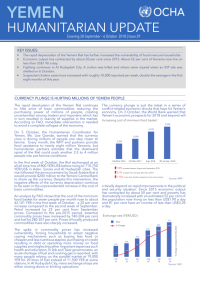Yemen Humanitarian Update Covering 28 September – 6 October 2018 | Issue 29
Key Issues:
- The rapid depreciation of the Yemeni Rial has further increased the vulnerability of food insecure households.
- Economic output has contracted by about 50 per cent since 2015. About 52 per cent of Yemenis now live on less than US$1.90 a day.
- Fighting continues in Al Hudaydah City. A civilian was killed and others were injured when an IDP site was shelled on 6 October.
- Suspected cholera cases have increased with roughly 10,000 reported per week, double the average in the first eight months of this year.
Currency Plunge is Hurting Millions of Yemeni People
The rapid devaluation of the Yemeni Rial continues to hike price of basic commodities reducing the purchasing power of millions of people, creating uncertainities among traders and importers which has in turn resulted in scarcity of supplies in the market.
According to FAO, immediate intervention is needed to avoid a complete collapse of the economy.
On 5 October, the Humanitarian Coordinator for Yemen, Ms. Lise Grande, warned that the currency crisis is driving millions of people one step closer to famine. Every month, the WFP and partners provide food assistance to nearly eight million Yemenis, but humanitarian partners estimate that the downward spiral of the Rial could push another 3.5 to 4 million people into pre-famine conditions.
In the first week of October, the Rial exchanged at an all all-time low of 800 YER/US$ before rising to 710-750 YER/US$ in Aden, Sana’a and Al Hudaydah cities. The rise followed the announcement by Saudi Arabia that it would provide $200 million to the Yemeni Central Bank to shore up the currency. Despite this intervention, the negative effects of the currency depreciation continue to be seen in the unprecedented increase in the cost of basic commodities.
An analysis by FAO shows that the cost of the minimum food basket for seven people per month rose to about 42,101 YER in the first week of October – a 25 per cent increase compared to the second week of September. Petrol increased by 23 per cent from September prices. Compared to the pre-2015 period, essential commodity prices have increased by 140-204 per cent and fuel by 280-357 per cent. Prices of locally produced commodities have also sharply increased.
The spike in commodity prices has increased vulnerability, forcing households to adopt negative coping mechanisms such as buying less food or cheaper and less nutritious staples; purchasing on credit resulting in debt or spending more money on food supplies and neglecting other important expenses such health and education. In Ibb and Taizz governorates, an acute shortage of fuel and cooking gas is reported, with many people relying on the parallel market at 19,000 YER for 20 litres of fuel instead of 11,500 YER at some stations. In Al Hudaydah City, many exchange shops are either closing-down or limiting operations.
The currency plunge is just the latest in a series of conflict-related economic shocks that have hit Yemen’s economy. On 3 October, the World Bank warned that Yemen’s economic prospects for 2018 and beyond will critically depend on rapid improvements in the political and security situation. Since 2015 economic output has contracted by about 50 per cent and poverty has dramatically increased with an estimated 52 per cent of the population now living on less than US$1.90 a day and 81 per cent have an income of less than US$3.20 a day.


